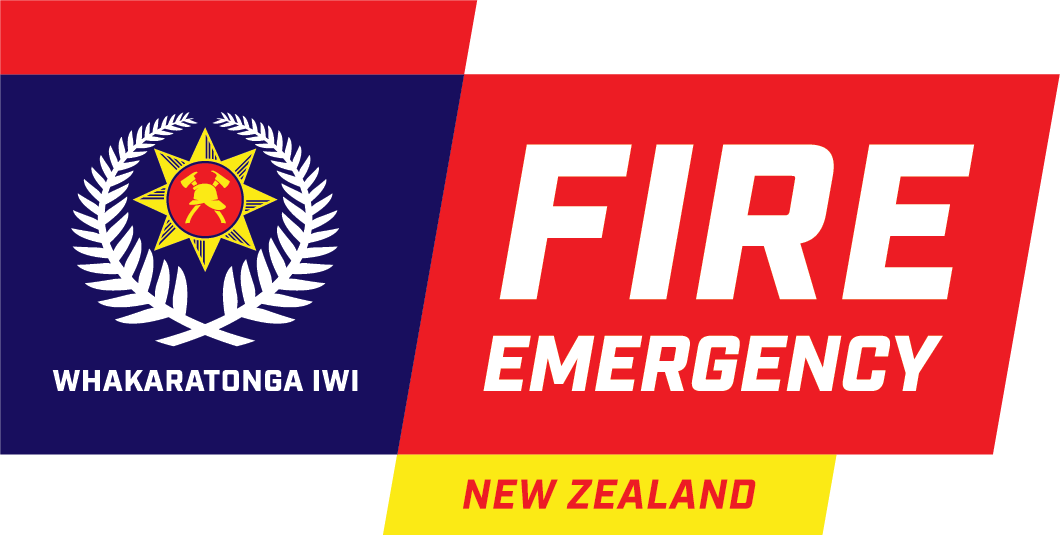Whiria te Tāngata – Rainbow Network
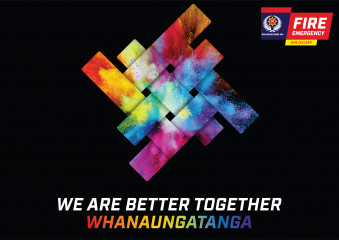 Who we are
Who we are
Whiria te Tāngata is a network of like minded people from across the organisation who aim to increase the visibility, inclusion and participation of people with diverse sexual orientation, gender identity and expression, and sex characteristics in Fire and Emergency.
Our first meeting was in early 2020, and much of the last year has focused on planning and forming the inital stages of the network. Key discussions and workshops helped identify the purpose, vision, objectives, identity and values of the network.
Who to contact
If you're interested in knowing more about Whiria te Tāngata - Rainbow Network, or joining our mailing list, please get in touch with us at: whiriatetangata@fireandemergency.nz
Join us on social media
We also have a Facebook group, which you can join here(external link)
Whiria te Tāngata is led by a governance group comprising representatives across the organisation.
You can view the members of the group here (requires a Fire and Emergency login).
You can contact the governance group at: whiriatetangata@fireandemergency.nz
We're keen to hear your feedback on this Portal area. Is there something that you think is missing? Is there anything you think we should expand on? We'd love to hear your ideas.
Just add 'Feedback' to the subject line and email: whiriatetangata@fireandemergency.nz
We'll get back to you as soon as possible.
Ngā Uara (Our Values)
Ngā Uara (Our Values) do not exist separately, but are woven together within each in every one of us. They provide a guide to our identity, our aspirations and shape how we support each other, our allies and the wider community. Through living our values, we not only create a space for our people to thrive but a space that allows our organisation to grow.
Kia Tika – We do the right thing
It is not just about being right, it’s our state of being! It’s what we do every day whether you sit on a truck or at a desk, kotahitanga means WE are all in this together. Whiria te Tāngata celebrates one another’s differences and champions a safe and inclusive workplace where you can bring your whole self to work. We will be up-standers against poor behaviour and inflexible systems that diminish the mana of others. Our people, our communities and our allies are at the centre of our decision-making and we will shine a light for others to follow.
Manaakitanga – We serve and support
This is about enhancing the mana of others, not just tolerating people but accepting our individual uniqueness and allowing our people to stand tall. The mana of Whiria te Tāngata shows our integrity, authenticity and desire to support others. Our manaaki will be carried through the weight of our words and through our leadership. We will build a whare that provides a space for our people and allies to thrive, but also benefits the wider organisation (the kerb cut effect).
Whanaungatanga – We are better together
This is us, banded together, coming together and better together. Like harakeke our strands are diverse and the bond that connects us to one other, to our allies and our wider community strengthens us all. We welcome you to this chosen whānau and we celebrate bringing your whole self to work – Wairua, Hinengaro, Tinana, Whānau, and recognise that we are all richer for it. It is okay to feel vulnerable within Whiria te Tāngata because harakeke is woven and our strength exists in each other.
Auahatanga – We strive to improve
This is celebrating our diversity which brings fresh ideas, innovation and creativity that improves the workplace environment for all of us. We strive to improve our ways of working through genuine and inclusive collaboration (whanaungatanga) whilst acknowledging the voices and stories of our past and present. We look to understand the challenges ahead so that our creativity, our innovation has a purpose. We strive to create comfortable and safe environments that allow people to be their best creative-self.
Two email signature graphics and three Microsoft Teams backgrounds for you to show your support for the network.
Instructions: Click on the image you want, it will download a high quality graphic file. Right click the downloaded file and select "Save image as". Save it on your desktop and upload it to your email signature or Teams background from there.
| Use | Graphic |
| Email signature graphic 1 |  [PNG, 13 KB] [PNG, 13 KB] |
| Email signature graphic 2 |  [PNG, 18 KB] [PNG, 18 KB] |
| Microsoft Teams background 1 | 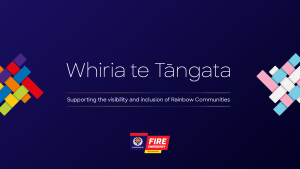 [PNG, 180 KB] [PNG, 180 KB] |
| Microsoft Teams background 2 | 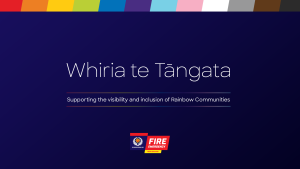 [PNG, 123 KB] [PNG, 123 KB] |
| Microsoft Teams background 3 |  [PNG, 109 KB] [PNG, 109 KB] |
Recent events
Sweat with Pride 2021
In June, six Fire and Emergency people from National Headquarters, Northern Comcen and our National Training Centre (NTC) participated in the "Sweat for Pride" fundraising event. They were all sponsored to raise funds to help improve mental and physical health in Aotearoa's Rainbow community.
It’s outrageous that in 2021, Aotearoa’s LGBTIQ+ communities have worse health outcomes than their peers. They worked up a sweat because who you love, how you identify or the pronouns you use shouldn’t negatively impact your health.
Twenty-one minutes a day is the minimum amount of physical activity we need for happy and healthy bodies and minds. While this may sound easy, research shows that 50% of New Zealanders aren't meeting this goal, which inspired the team to make a difference.
Together, team members completed 6,151 minutes of exercise. Mark Richards from the Northern Comcen amassing an impressive total fitness time of 3,756 minutes of exercise, followed by Michelle Forrest from NTC with 1,103 minutes.
The Fire and Emergency team set a $1,500 goal and exceeded that by raising $2,591. The highest fundraiser was Niamh McNamara, from NHQ, who raised $940, followed by Cindy Thompson, also from NHQ, who raised $670.
See the details of the Team's efforts. (external link)
Cross Agency Rainbow Network (CARN) Conference 2021
The Cross Agency Rainbow Network (CARN) Conference 2021 was held in Parliament Buildings Thursday 25 – Friday 26 March. The 2021 conference was the second national CARN hui and the first that Fire and Emergency have attended. The aim of the conference, as per their website, was…to equip public service decision makers with a better understanding of the experiences of our rainbow communities, to help drive sustainable actions that meet the needs of our communities and enhance our safety and well-being. In keeping with this kaupapa, we have brought back the learnings of other government agencies who have been working more closely with their rainbow whānau in recent years and included in this report a list of actionable items that we believe can help Fire and Emergency better meet the needs of our internal communities, as well as the ones we serve.

Image L-R: Jacob Davies, Business Operations Manager, Te Ūpoko, Cindy Thompson, Business Analyst, NHQ, Allan Stoddart, Education Technologies Advisor, NHQ, Mark Richards, Operations Manager, Northern Communications Centre, Michelle Forrest, Learning Development Advisor, NTC, AJ Burton, Volunteer Rural Firefighter, Waitaki, Daniel Colbeck, Career Firefighter Seaview, Niamh Mc Namara, Volunteer Learning Advisor / Volunteer Urban Firefighter, Featherston.
Fire and Emergency strides with pride
Fire and Emergency was well represented at the Auckland Rainbow Pride Parade with 35 of our people and their whānau taking part in the Parade in 2021, some travelling from as far as Ruakaka, Rotorua, Taupō and Wellington.
The then-National Commander Kerry Gregory said it was a fantastic afternoon walking in the parade with our people and their whānau and “co responding” alongside our colleagues from St John.
“Taking part in the Pride parades each year is an important celebration of our communities and the diverse communities we serve,” says Kerry.
“Diversity is an important part of who we are and it’s reflected in our organisational value of we are better together – whanaungatanga.
“Special thanks to those who helped organise our attendance at the event, in particular Northern Communication Centre Operations Manager, Mark Richards and National Training Centre Learning Development Advisor, Michelle Forrest.
“And to the Birkenhead Volunteer Fire Brigade whose appliance was parked along the parade, colourfully decorated and equipped with a bubble machine and toy waterguns to provide entertainment for the crowd.”
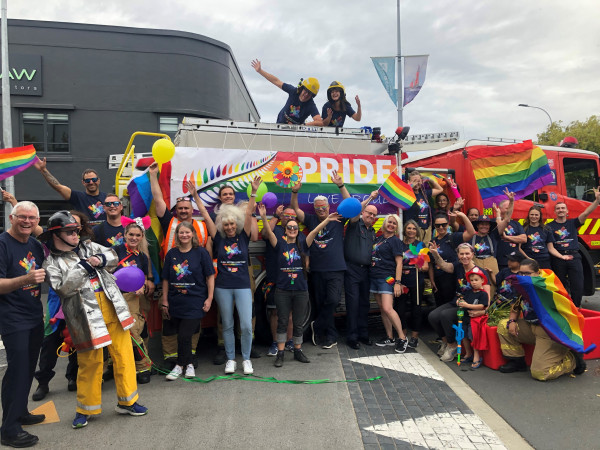
Mark Richards said it was great to see all the support from Fire and Emergency on the day.
“It’s important our people can be their true selves at work or while volunteering for Fire and Emergency and know they are supported – whether they are an ally or part of the rainbow community,” says Mark.
“It was a really fun event and everyone is looking forward to next year!”
Glossary and definitions
|
Term |
Meaning |
|
Ace |
Ace is a colloquial abbreviation of asexual and/or aromantic. Often used as an umbrella term to cover the range of identities that fall under the ace spectrum, it is a term to refer to asexual people in a similar manner that ‘gay’ or ‘straight’ is used to refer to homosexual or heterosexual people. Ace also includes grey-asexual and demisexual people and recognises |
|
Agender |
Someone who feels neutral towards their gender and rejects the influence of gender on their person. Sometimes the term non-gendered is used in a similar fashion. |
|
Ally |
Someone who is a friend and active supporter of Rainbow communities. This term can be used for non-LGBTQIA+ allies as well as those within Rainbow communities who support each other. For example, a bisexual woman who is an ally to trans, non-binary, and intersex people. Allyship is always a process of learning and recognises that no-one is perfect. |
|
Aromantic |
A person who experiences little to no romantic attraction but may experience sexual attraction towards others. |
|
Asexual |
A person who either does not, or does not often, experience sexual attraction but may experience romantic attraction towards others. This can also be used as an umbrella term, like ‘ace’, that encompasses a range of other ace spectrum identities. |
|
Bisexual |
A person who is emotionally and sexually attracted to their own and other genders. |
|
Cisgender |
Pronounced as either ‘siz’ or ‘çiss’ ‒ a person whose gender aligns with their sex assigned at birth. |
|
Discrimination |
Means to be treated unfairly or less favourably than others in similar circumstances. Many people face discrimination because of their actual or perceived sexual orientation, gender identity and expression, or sex characteristics. |
|
Diversity |
The wide variety of shared and different personal and group characteristics among human beings. |
|
Dominant culture |
The cultural values, beliefs and practices that are assumed to be the norm and are most influential within a given society. |
|
Gay |
A person who is attracted to the same gender. This is more widely used by men than women and can be both a personal and community identity. |
|
Gender |
Gender is an individual’s internal sense of being a woman, a man, neither of these, both or somewhere along a spectrum. Gender is not fixed or unable to be changed. |
|
Gender expression |
A person’s presentation of their gender through physical appearance (including dress, hairstyles, accessories, cosmetics), mannerisms, speech, behavioural patterns, names, and personal references. Gender expression may or may not conform to a person’s gender identity. |
|
Gender diverse |
A person who does not conform to their society or culture’s dominant gender roles. |
|
Gender identity |
Gender identity is an individual’s sense of being a woman, a man, neither of these, both or somewhere along a spectrum. |
|
Genderfluid |
A non-binary gender that indicates shifting between different genders or presentations. |
|
Heterosexual |
A person who is sexually attracted to people of the other binary gender. Straight is an alternative term. |
|
Hijra |
A word used in the Indian subcontinent to describe intersex people, and transgender people. This community also use the words Kinnar or Kinner to describe themselves. |
|
Homosexual |
A person who is sexually attracted to people of the same gender. Alternative terms used are gay and lesbian. |
|
Ia |
In te reo Māori, there is no gendered singular pronoun. Regardless of gender or sex, a person’s pronoun is ‘ia’. |
|
Inclusion |
Providing equal opportunity for participation, so that everyone can be and feel welcomed, respected, supported, and valued to fully participate. |
|
Intersectionality: |
A framework to explain how multiple social categories |
|
Intersex |
“An umbrella term used to describe people born with physical or biological sex characteristics (including sexual anatomy, reproductive organs, hormonal patterns and/or chromosomal patterns) that are more diverse than stereotypical definitions for male or female bodies. Like all people, intersex people may identify as male, female or non-binary and can have any sexual orientation. “ |
|
Lesbian |
“A woman who is attracted to other women. This is used as both a personal |
|
LGBTQIA+ |
“An acronym which stands for Lesbian, Gay, Bisexual, Transgender, Intersex, Queer, Intersex, Asexual or Ace. The + recognises there are further identities not listed, and while the combination and number of letters varies, the overall LGBTQIA+ acronym is well-recognised.” |
|
Non-binary |
“An umbrella term for gender identities outside the male/female binary. “ |
|
Pasifika terms:
|
These make up the acronym MVPFAFF These are some terms used by Pacific peoples to describe cultural and gender identities. These concepts are more, or just as much, about familial, genealogical, social, and cultural selfhood. This is not an exhaustive list of Pacific peoples’ terms. These cultural and gender identities do not often have an equivalent in English language/terminology. |
|
Pansexual |
A person who is attracted to people regardless of their gender. |
|
Privilege |
A set of benefits given to people who fit into a specific social group. Privilege exists in many forms including within Rainbow communities. |
|
Pronouns are referential markers that we use to refer to ourselves and others. Common pronouns are she/her/hers, he/him/his, and they/them/theirs. Pronouns are self-defined and are not “preferred”. |
|
|
Queer |
Historically used as a derogatory term for something/someone being different. This word has been reclaimed by some people as an umbrella term for sexual and gender minorities who are not heterosexual or cisgender. Note – due to this history, it is best not to initiate the use of this term to refer to others unless this is how they describe themselves. |
|
Questioning
|
A person who may be exploring and discovering their own sexual orientation or gender. |
|
Rainbow |
An umbrella term that covers all sexual and gender minorities, and people with variations of sex characteristics and avoids the acronym LGBTQIA+. This can be used to identify communities as well as an individual. |
|
Safe space |
Refers to an environment in which everyone feels comfortable expressing themselves and participating fully without fear of attack, ridicule, or denial of experience. |
|
Sex |
The sex characteristics associated with being female or male. |
|
Sex assigned at birth |
The sex a baby is assigned at birth, usually determined by a visual observation of external genitalia. A person’s gender may or may not align with their sex assigned at birth. |
|
Sex characteristics |
A person’s physical features relating to sex, including genitalia and other sexual and reproductive anatomy, chromosomes, hormones, and secondary physical features emerging from puberty. |
|
Sexual orientation |
A term that covers three key aspects: sexual attraction, sexual behaviour and sexual identity. These are related – sexual orientation is generally based on sexual attraction; sexual attraction can result in different sexual |
|
Sexual attraction |
Sexual interest in another person. Sexual attraction is having sexual feelings towards someone. |
|
Sexual behaviour |
Sexual interest in another person. Sexual attraction is having sexual feelings towards someone. |
|
Sexual identity |
How a person thinks of their own sexuality and the terms they identify with. |
|
SOGIESC |
An acronym which stands for Sexual Orientation, Gender Identity and Expression, and Sex Characteristics. |
|
Straight
|
A person who is attracted to people of the other binary gender. Heterosexual is an alternative term. |
|
Taahine |
Taahine is similar to mixed gender, sometimes non-binary, or transgender not-otherwise specified. This speaks to the intersection of Māori and non-cisgender identities. |
|
Takatāpui |
A traditional term reclaimed by Māori to encompass both their culture and spirituality, as well as their diverse sexual orientations, gender identities and expressions, and sex characteristics. |
|
Tangata ira tāne |
A te reo Māori term which roughly translates as trans man. |
|
Titles |
One or more words used before a person’s name, in certain contexts, including Mr, Miss, and Mrs. An example of a gender-neutral title is ‘Mx,’ usually pronounced 'mix'. Mx can be used by a person of any gender, whether they are trans or cis. |
|
Trans |
Used as an abbreviation of either transgender or transsexual, or as an umbrella term in the same way that transgender is used. |
|
Transgender |
This term describes a wide variety of people whose gender is different from the sex they were assigned at birth. Transgender people may be binary or non-binary. |
|
Transitioning |
The process a transgender person may take to affirm their gender. It may involve social, legal, and/or medical steps. |
|
Trans man |
A man who was assigned female at birth. It is grammatically and definitionally correct to include a space between trans and man. |
|
Trans woman |
A woman who was assigned male at birth. It is grammatically and definitionally correct to include a space between trans and woman. |
|
Transsexual |
This term is generally considered to be outdated and tends not to be used by younger generations. It may refer to a person who has changed (or is in the process of changing) their body to affirm their gender. |
|
Whakawahine |
There is no direct English translation, but roughly translates as trans woman. More literally, it translates as being or becoming, in the manner or spirit of a woman. |
Pride
Pride celebrates the rich cultural diversity of the communities we serve and offers a chance to bring our people together, have fun, and highlight issues relevant to rainbow communities on both a local and international level.
Fire and Emergency have developed a strong presence at Pride. The event shows our support for rainbow communities and those who identify as LGBTQI+ within both our organisation and throughout New Zealand and beyond.
Every year our people love getting involved with Pride events and parades, and we encourage you to join us and march alongside your colleagues. You can also get involved with the organising committee, and we also need people to marshal and drive our fire appliances, as well as enthusiastic flag wavers and water gun sprayers, so there are plenty of options.
To register interest and ask us any questions, email Pride@fireandemergency.nz
We’re proud to ‘stride with pride’ and represent Fire and Emergency!
Pride news on the Portal
Fire and Emergency strides with pride (published 1 April 2021)
Taking pride and in who we are and who we serve (published 11 March 2020)
Stepping up and stepping out at Pride (published 23 February 2018)
Resources
- PRISM report [PDF, 2.2 MB] (Human Rights NZ)
- Takatapuī [PDF, 15 MB] (also available from the NHQ library)
- Ingoa Maori [PDF, 212 KB] (how we got our name)
- Year 1 - Annual Report [DOCX, 1.6 MB]
- Glossary of terms
- FENZ Interim policy: Event-specific uniform items (includes pins and rainbow epaulettes).(external link)
- FENZ Diversity and Inclusion Strategy(external link)
- WeCount 2019 [PDF, 971 KB]
- Event-specific uniform items [PDF, 590 KB] - guidelines for event-specific uniform items to show support for different causes
Last modified:
